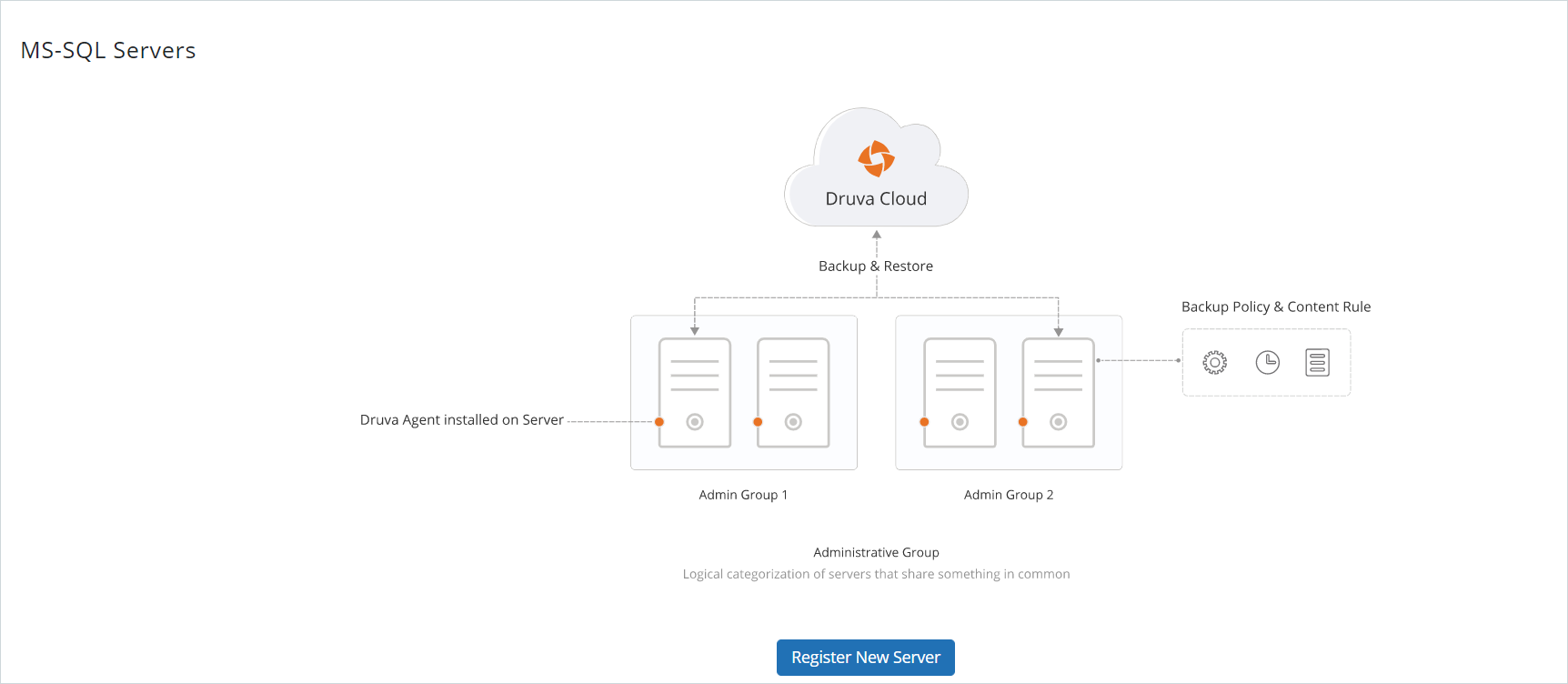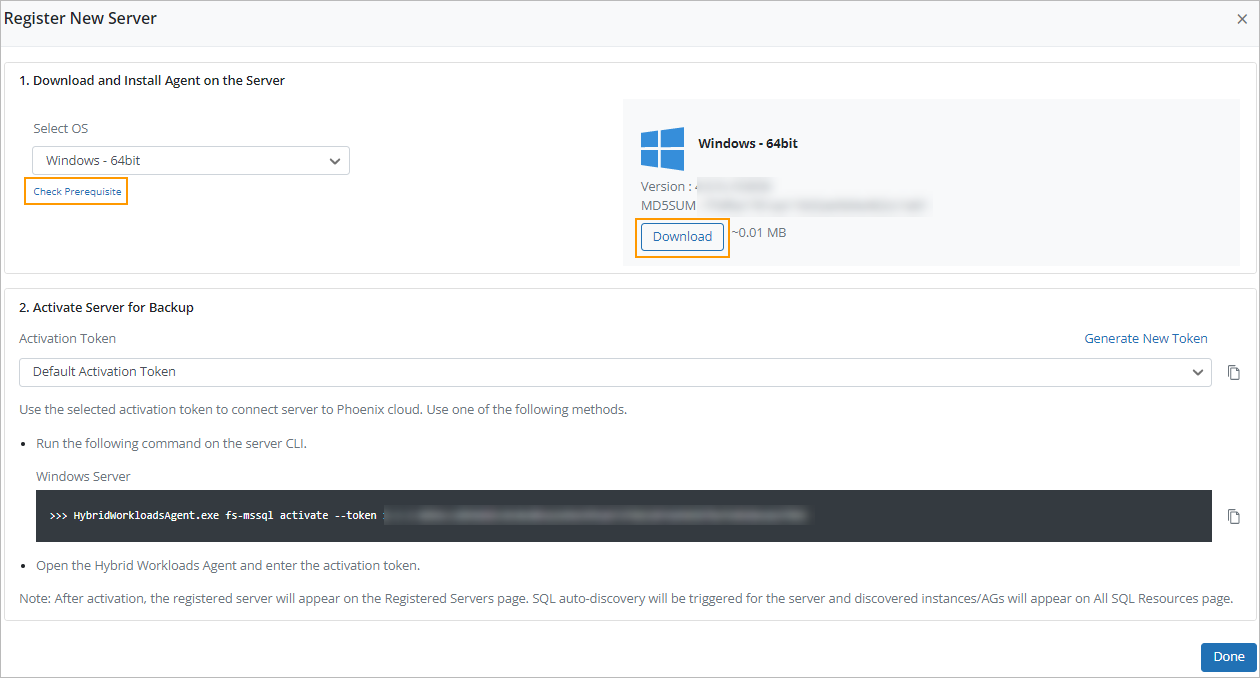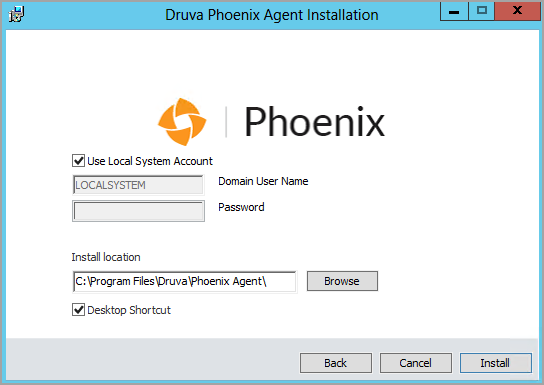Install the agent and register an MS-SQL server
 Business
Business  Enterprise
Enterprise  Elite
Elite This article explains the following steps while setting up Druva to backup your MS-SQL server:
- Download and install the Hybrid Workloads agent
- Activate the Hybrid Workloads agent
- (Optional) Configure Web proxy
Before you begin
Before you can set up Druva in your infrastructure, ensure that you have configured organizations and administrators. For more information, see Quick steps to set up Druva to back up databases.
Ensure that you read through the system requirements and prerequisites.
Download and install the Hybrid Workloads agent
-
Log in to the Management Console.
- Select the workload from the Protect menu. Note that if the All Organizations menu is enabled, you have to first select an organization where you want to add the MS-SQL server and then select the workload.
- The Get Started page is displayed if no SQL servers have been configured so far.

On the Get-Started page, click Register New Server. - If SQL servers have already been configured in your environment, you can register additional SQL servers, by clicking Register New Server from the All SQL Resources page.

- In the Register New Server dialog box, click Check prerequisites to ensure that the MS-SQL server where you want to install the Hybrid Workloads agent meets the MS-SQL server requirements.

-
Under the Download and install agent on the server section, click Download. Copy the installable to the MS-SQL server if you didn't download the agent from a Management Console open on the MS-SQL server.
Note: Using this Hybrid Workloads agent, you can protect File Servers, NAS, and Hyper-V workloads on a Windows Server or Linux Server. For more information, see Common agent installation and activation.
-
On the MS-SQL server, navigate to the location which has the Hybrid Workloads agent installer.
-
Double-click the Druva installer, and click Next.
- Use either the local system account or domain admin credentials while installing the agent. To use domain admin credentials, clear the Use Local System Account checkbox. Enter the domain account username in the format: domain\username.

-
In the Install location box, type or select the full path to the installation home directory.
-
Click Install.
-
After the installation completes, click Finish.
If you use the domain user account at the time of installing the agent, ensure that you create the domain user account credentials in the credential store and then use those credentials. Credentials stored in the Credential store persist through upgrades. For more information see Credential Store.
Command-line install
Execute the following command from the command prompt:
msiexec /i <path to Phoenix msi> /qn /quiet /log <path to log file>
For example: msiexec.exe/i C:\Users\Administrator\Downloads\Phoenix-6.0.1-154609.msi /qn/quiet/log C:\Users\Administrator\Downloads
Note: If you install the agent using the command line instruction, the agent is installed with the local system administrator account. You cannot provide the domain account credentials if you use this method.
Activate the Hybrid Workloads agent
After you install the Hybrid Workloads agent on a Windows server, you must activate it using the activation token that Druva generated at the time of registering servers. The token functions as a unique identifier and performs a one-time authentication of Hybrid Workloads agents. After authentication, Hybrid Workloads agents establish a persistent connection with Druva Cloud.
Note: If your network infrastructure uses a Web proxy, you must configure it before activation. For more information, see Configure Web proxy.
- In the Register New Server wizard, under the Activate Server for Backup section, select a valid activation token. An activation token can be used to activate up to 25 servers and expires in 7 days. If all activation tokens have expired, Druva creates a Default Activation Token automatically when you click Register New Server.

-
If you want to create a new token, perform the following tasks:
-
Click Generate New Token.
- In the Generate Token dialog box, enter the following details, and click Generate.
- Token Label: Enter a unique label for the activation token.
- This token can activate: Enter the number of servers that can be activated using this token.
- This token expires in: Enter the number of days after which this token will expire.
- In the Generate Token dialog box, click Generate.
- Select the newly generated token from the drop-down list under Activation Token.
Note: Druva lists the activation token under Manage > Activation Tokens. For more information, see Manage activation tokens.
-
- If you’re using the CLI to activate the agent, click Copy Command.

- On the MS-SQL server, open a CLI.
Note: If you are using an agent older than version 6.0.1-154928, navigate to C:\Program Files\Druva\Phoenix Agent
- Paste the copied command and press Enter. You can also append the server name by editing the command:
HybridWorkloadsAgent.exe fs-mssql activate -t <activation token> --ServerName <Server Name>
For example: HybridWorkloadsAgent.exe fs-mssql activate -t 32931-228-1762-591132241ce4fb2e14fca792cbf532f4a2359eb0bf1b96f82211373ebea7c23b -n WIN-RFE3
Note: If you are using an agent older than version 6.0.1-154928, the following command can be used:
For GovCloud, the edited command:
PhoenixActivate <activation token> --ServerName <Server Name>HybridWorkloadsAgent.exe fs-mssql activate govcloud -g -t <token> --ServerName <Server Name>
For example: HybridWorkloadsAgent.exe fs-mssql activate -g -t 32931-228-1762-591132241ce4fb2e14fca792cbf532f4a2359eb0bf1b96f82211373ebea7c23b -n WIN-RFE3
Note: If you are using an agent older than version 6.0.1-154928, the following command can be used:
PhoenixActivate govcloud <activation token> --ServerName <Server Name>
- On the MS-SQL server, open a CLI.
Note: The server name is not case sensitive. You cannot have one server registered as "ABC and another as "abc". Druva displays the error message Server display name already exists. Cannot register the server with same display name.
- If you’re using the Hybrid Workloads agent shortcut to activate the agent, click Copy Token.

- Double-click the Hybrid Workloads Agent shortcut on the server where the Hybrid Workloads Agent needs to be activated.
The Hybrid Workloads Agent window is displayed.

- In the Hybrid Workloads Agent window, select FS & MS-SQL to activate.
A set of in-built activation checks are run and the result is displayed.
The Agent Activation page for FS & MS-SQL is displayed.

- Enter the following details:
- Double-click the Hybrid Workloads Agent shortcut on the server where the Hybrid Workloads Agent needs to be activated.
| Field | Description |
|---|---|
| Activation Token | Paste the copied activation token.
Note: This is the token copied from the Register New Server dialog box. |
| Server Name | Enter a unique server name in the current Organization for each workload of the same type.
Note: The server name should not contain any special characters. |
Note: If you are activating the agent for Druva Public Cloud, do not select the GovCloud check box.
- Click Activate.
The backup readiness checks will run to ensure that your system is equipped for successful backup operation.
After activation, the registered server is visible under Protect > File Servers > Registered Servers page as well as the Protect > MS-SQL servers > All SQL Resources page. The All SQL Resources page also displays the instances and availability groups hosted on the server.
Note: Server or SQL resources may take some time to appear under Protect > MS-SQL servers, as they are populated once the discovery of SQL databases is done successfully.
Configure Web proxy
Hybrid Workloads agent connects to the Druva Cloud through the internet. If your network infrastructure uses a Web proxy, configure the Hybrid Workloads agent to use Web proxy to establish a connection with the Druva Cloud. You can configure the Web proxy either from the user interface or command line.
Configure Web proxy servers using the command line
- Open the command-line interface window.
- In the command line interface, change the directory with which the CLI opens to the directory where Hybrid Workloads agent is installed.
Note: If you are using an agent older than version 6.0.1-154928, change directory to C:\Program Files\Druva\Phoenix Agent.
- In the command prompt, run the following command to set the Web proxy:
HybridWorkloadsAgent.exe web-proxy-config -s -t <proxy_type> -i <ProxyHost_IP>:port -u <Proxy_user> -p <Proxy_password>For example: HybridWorkloadsAgent.exe web-proxy-config -s -t http -i 172.34.23.218:80 -u johndoe -p pass23Note: If you are using an agent older than version 6.0.1-154928, the following command can be used:
PhoenixControl.exe set_proxy_details -t proxy_type -i proxy_IP:port -u proxy_user -p proxy_password - (Optional)You can use the following command to fetch the current proxy configuration:
HybridWorkloadsAgent.exe web-proxy-config -g
| Field | Description |
|---|---|
| Get_web-proxy (-g, --get) |
Fetches the current Web proxy configuration for the agent. |
| Set_web_proxy (-s, --set) |
Sets the current Web proxy configuration for the agent. |
| Proxy_type (-t, --proxy-type string) |
Agent supports the following proxy types:
Note: If you do not provide the type, http is applied by default. |
| Proxy_IP (-i, --host string) |
Valid IP or URL of proxy server. |
| Port | Respective proxy port number. |
| Proxy_user (-u, --user string) |
Valid proxy user name. |
| Proxy_password (-p, --pass string) |
Valid proxy password. |
The Web proxy is configured successfully.
Note: Druva only supports basic authentication with Web proxy.
Additional information
- The Threat Management Gateway (TMG) drops IDLE connections after defined timeout duration, due to which agent does an aggressive retry with server.
Note: In TMG application, it is recommended to set connection timeout value to 5 minutes.
- The configuration file path for Hybrid Workloads agent and Cache Server are as follows:
For windows agent:C:\ProgramData\Phoenix\Phoenix.cfg.
- If the proxy details setting fails, ping the proxy-server IP from the same machine and check for proxy_user and proxy_password.
Next step
After your SQL server is registered, you can configure it for backup.

